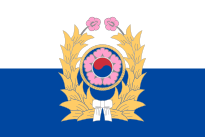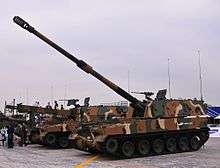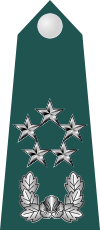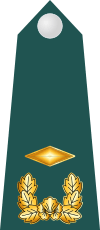Republic of Korea Army
The Republic of Korea Army (ROKA; Korean: 대한민국 육군; Hanja: 大韓民國 陸軍; Revised Romanization: Daehanminguk Yuk-gun), also known as the ROK Army, is the army of South Korea, responsible for ground-based warfare. It is the largest of the military branches of the Republic of Korea Armed Forces with 464,000 members as of 2018. This size is maintained through conscription; South Korean men must complete 21 months of military service between the age of 18 and 35.[7]
| Republic of Korea Army | |
|---|---|
| 대한민국 육군 大韓民國 陸軍 Daehanminguk Yuk-gun | |
 Coat of arms of the Republic of Korea Army | |
| Founded | September 5, 1948 |
| Country | |
| Type | Army |
| Role | Ground warfare |
| Size | 464,000 (2018)[1] |
| Part of | |
| Garrison/HQ | Gyeryong, South Chungcheong, South Korea |
| Nickname(s) | "ROK Army", "ROKA", "South Korean army" |
| Motto(s) | "A Strong Friend, Republic of Korea Army" (Korean: 《강한친구 대한민국 육군》) |
| March | "Army Anthem" (Korean: 《육군가》, romanized: Yukgunga)[2][3][4][5][6] |
| Mascot(s) | Hogugi (Korean: 호국이) |
| Equipment | 2,300 main battle tanks 2,800 armored fighting vehicles 5,800 artillery pieces 200 multiple rocket launchers 60 guided missile systems |
| Engagements | Korean War Korean DMZ Conflict Vietnam War Persian Gulf War War in Afghanistan Iraq War |
| Website | Official website |
| Commanders | |
| Commander-in-Chief | President Moon Jae-in |
| Minister of National Defense | Jeong Kyeong-doo |
| Chief of Army Staff | General Suh Wook |
| Insignia | |
| Flag |  |
History


The modern South Korean army traces its lineage back to the Gwangmu Reform, when the Beolgyegoon was established by Emperor Gojong in 1881.
The 1st of every October is celebrated in South Korea as Armed Forces Day. It commemorates the day during the Korean War when units of the ROK Army first crossed the 38th Parallel, thus leading the UN Coalition north into North Korean territory for the first time.
The National Security Guard Of South Korea was originally formed out of the Republic Of Korea Army. This organization was created during the United States-lead occupation period from 1945–1948. The National Security Guard Of South Korea was initially a reserve unit of the National Police. In addition to some Nationalist Chinese and post-Manchurian soldiers remnants of the Imperial Japanese Army also contributed to the force. The National Defense Force was established on January 15, 1946 replacing the United States lead constabulary from 1945.
The outbreak of the Korean War caught the South Korean forces unprepared, requiring the United Nations to intervene with U.S.-led forces. The South Korean military rapidly developed during the Korean War, suffering enormous casualties and loss of equipment. As the Soviets had armed North Korea, the United States armed and trained the South Korean military throughout the Korean War.
Current operational status
The South Korean army is structured to operate in both the mountainous terrain native to the Korean Peninsula (60% mountainous) and in North Korea with its 950,000 strong Korean People's Army Ground Force, two-thirds of which is permanently garrisoned in the frontline near the DMZ. The current administration has initiated a program over the next two decades to design a purely domestic means of self-defense, whereby South Korea would be able to fully counter a North Korean attack.
The ROK Army was formerly organized into 3 armies: the First Army (FROKA), Third Army (TROKA) and Second Operational Command. Each with its own headquarters, corps, and divisions. The Third Army was responsible for the defense of the capital as well as the western section of the DMZ. The First Army was responsible for the defense of the eastern section of the DMZ whereas the 2nd OC formed the rearguard.
Under a restructuring plan aimed at reducing redundancy, the Second ROK Army was converted as the Second Operations Command in 2007, and the First and Third ROK Armies were merged as the Ground Operations Command in 2019.
Equipment
The army consists of 495,000 troops, approximately 2,400-2,500 tanks, 2,700 armored fighting vehicles, 5,800 artillery pieces, 60 guided missile systems, and 600 helicopters as of 2014. Main battle tank types include: 880 M48 Patton series and its upgrades such as M48A3K, M48A5, and M48A5K, 33 Soviet T-80U and 2 T-80UK (given by Russia to pay off debt), as well as 1,524 K1A1 and K1 tanks, which bear a 120 mm smoothbore gun and are of local manufacture. The future replacement for the K1 and K1A1 MBTs has been named the K2 Black Panther (흑표;黑豹 Heukpyo), which will be fitted with a 1500 hp MTU-based engine, 55-caliber 120 mm main gun with autoloader. The new tank will also feature radar equipment as well as all-bearing laser detection and defense systems, anti-missile active protection, and heavy reactive armor and sensor package comparable to the American M1A2 Abrams and German Leopard 2A6. The ROK Army is planning to field approximately 390 Black Panthers.
In addition Republic of Korea manufactures the K-9 howitzer which have been exported to Turkey as the T-155 howitzer as well as the ZMA series TIFV's which saw action in UN peacekeeping operations (PKO) as part of the Malaysian peacekeeping forces. A variation of the K200, the KAFVs can be retrofitted to bear a 90 mm cannon, 40 mm grenade turret, M230-1 Chain gun Turret, or MK-30 Chaingun Turret. A replacement for K200 series IFVs are currently being tested, designated as K21 KNIFV (Korea Next generation Infantry Fighting Vehicle), which will have various capabilities for both land and naval warfare. The initial production is set for 2008, with the ROKA planning to field approximately 1,000 units until 2015.
The K21 KNIFV's chassis will be constructed entirely out of fiberglass, reducing the vehicle's load and enabling it to travel at higher speeds without bulky and powerful engines. When constructed, the NIFV will be lighter than other IFVs, including the American Bradley series and Russian BMP series, increasing both speed and payload.
The ROK Army also fields the mobile K-SAM "Pegasus"(천마/天馬; Cheonma), fitted with 8 missiles that fly at maximum speeds of mach 2.6, and the K-30 "Biho" series, which features a 30 mm twin gun system for anti-aerial fire support.
Besides having vehicles and equipment of their own design as well as American models, the ROK Army also possesses inventories of Russian-built AFVs, including BMP-3 IFVs and T-80U MBTs, given by the Russian government to pay off the financial debt owed to South Korea. Other notable foreign equipment in service with the ROK Army includes the Mistral MANPADS.
A new infantry rifle, the Daewoo K11 entered service in 2010. The overall concept of this weapon is similar to the American OICW, however it has recently been halted on production and abandoned due to too many issues targeting issues.
Organization
.jpg)

Republic of Korea Army Headquarters (대한민국 육군본부)
- Capital Defense Command 'SHIELD' (수도방위사령부 '방패부대')[8]
- 1st Air Defense Brigade (1방공여단)
- 52nd Homeland Defense Infantry Division (52향토보병사단)
- 56th Homeland Defense Infantry Division (56향토보병사단)
- Special Warfare Command 'LION' (특수전사령부 '사자부대')
- 1st Special Forces Brigade (Airborne) 'EAGLE' (1공수특전여단 '독수리부대')
- 3rd Special Forces Brigade (Airborne) 'FLYING TIGER' (3공수특전여단 '비호부대')
- 7th Special Forces Brigade (Airborne) 'PEGASUS' (7공수특전여단 '천마부대')
- 9th Special Forces Brigade (Airborne) 'GHOST' (9공수특전여단 '귀성부대')
- 11th Special Forces Brigade (Airborne) 'GOLDEN BAT' (11공수특전여단 '황금박쥐부대')
- 13th Special Forces Brigade (Airborne) 'BLACK PANTHER' (13공수특전여단 '흑표부대')
- Aviation Operations Command 'PHOENIX' (항공작전사령부 '불사조부대')
- 1st Aviation Brigade (1항공여단)
- 2nd Aviation Brigade (2항공여단)
- Army Missile Command 'ENDLESSNESS' (미사일사령부 '무극부대')
- Army Training & Doctrine Command 'CREATION' (육군교육사령부 '창조대')
- Army Personnel Command (육군인사사령부)
- Army Logistics Command 'SEVEN STARS' (육군군수사령부 '칠성대')
- Army Mobilization Force Command (육군동원전력사령부)
- 60th Reserve Infantry Division (60동원보병사단)
- 66th Reserve Infantry Division (66동원보병사단)
- 72nd Reserve Infantry Division (72동원보병사단)
- 73rd Reserve Infantry Division (73동원보병사단)
- 75th Reserve Infantry Division (75동원보병사단)
- Korea Army Academy at Yeongcheon (육군3사관학교)
- Korea Military Academy (육군사관학교)
Ground Operations Command (GOC) (지상작전사령부)
- 36th Homeland Defense Infantry Division 'WHITE TIGER' (36향토보병사단 '백호부대')
- 1st Logistical Support Command (1군수지원사령부)
- 3rd Logistical Support Command 'THREE HORSES' (3군수지원사령부 '삼마부대')
- Capital Corps 'DEVOTION' (수도군단 '충의부대')
- Capital Artillery Brigade (수도포병여단)
- 17th Infantry Division 'LIGHTNING' (17보병사단 '번개부대')
- 51st Homeland Defense Infantry Division 'TOTAL VICTORY' (51향토보병사단 '전승부대')
- 55th Homeland Defense Infantry Division 'BEACON FIRE' (55향토보병사단 '봉화부대')
- I Corps 'GWANGGAETO' (1군단 '광개토부대')
- 2nd Armored Brigade 'LOYALTY' (2기갑여단 '충성부대')
- 30th Armored Brigade (30기갑여단)
- 1st Artillery Brigade 'FLYING TIGER' (1포병여단 '비호부대')
- 1st Engineer Brigade (1공병여단)
- 1st Infantry Division 'FORWARD' (1보병사단 '전진부대')
- 9th Infantry Division 'WHITE HORSE' (9보병사단 '백마부대')
- 25th Infantry Division 'WYVERN' (25보병사단 '비룡부대')
- II Corps 'DOUBLE DRAGONS' (2군단 '쌍용부대')
- 3rd Armored Brigade 'LIGHTNING' (3기갑여단 '번개부대')
- 2nd Artillery Brigade (2포병여단)
- 2nd Engineer Brigade (2공병여단)
- 7th Infantry Division 'SEVEN STARS' (7보병사단 '칠성부대')
- 15th Infantry Division 'VICTORY' (15보병사단 '승리부대')
- 27th Infantry Division 'LET'S WIN' (27보병사단 '이기자부대')
- III Corps 'MOUNTAINS' (3군단 '산악부대')
- 20th Armored Brigade (20기갑여단)
- 3rd Artillery Brigade (3포병여단)
- 3rd Engineer Brigade (3공병여단)
- 12th Infantry Division 'EULJI' (12보병사단 '을지부대')
- 21st Infantry Division 'MT. BAEKDU' (21보병사단 '백두산부대')
- V Corps 'VICTORIOUS ADVANCE' (5군단 '승진부대')
- 1st Armored Brigade 'BLITZKRIEG' (1기갑여단 '전격부대')
- 5th Artillery Brigade 'VICTORIOUS ADVANCE' (5포병여단 '승진포병부대')
- 5th Engineer Brigade (5공병여단)
- 3rd Infantry Division 'WHITE SKULL' (3보병사단 '백골부대')
- 6th Infantry Division 'BLUE STAR' (6보병사단 '청성부대')
- VI Corps 'ADVANCE' (6군단 '진군부대')
- 5th Armored Brigade 'IRON STORM' (5기갑여단 '철풍부대')
- 6th Artillery Brigade (6포병여단)
- 6th Engineer Brigade (6공병여단)
- 5th Infantry Division 'THE KEY' (5보병사단 '열쇠부대')
- 28th Infantry Division 'INVINCIBLE TYPHOON' (28보병사단 '무적태풍부대')
- VII maneuver Corps 'VANGUARD' (7 기동군단 '북진선봉부대')
- 7th Artillery Brigade (7포병여단)
- 7th Engineer Brigade (7공병여단)
- Capital Mechanized Infantry Division 'TIGER' (수도기계화보병사단 '맹호사단')
- 8th Mechanized Infantry Division 'TUMBLER' (8기계화보병사단 '오뚜기부대')
- 11th Mechanized Infantry Division 'HWARANG' (11기계화보병사단 '화랑부대')
- 2nd Rapid Reaction Division (Airborne) (2신속대응사단)
- VIII Corps 'DRAGON OF THE EAST SEA' (8군단 '동해충용부대')
- 102nd Armored Brigade 'SUNRISE' (102기갑여단 '일출부대')
- 22nd Infantry Division 'YULGOK' (22보병사단 '율곡부대')
- 23rd Infantry Division 'IRON WALL' (23보병사단 '철벽부대')
Second Operations Command (2OC) (제2작전사령부)
- 201st Special Assault Brigade (201특공여단)
- 203rd Special Assault Brigade (203특공여단)
- 5th Logistical Support Command (5군수지원사령부)
- 31st Homeland Defense Infantry Division (31향토보병사단)
- 32nd Homeland Defense Infantry Division (32향토보병사단)
- 35th Homeland Defense Infantry Division (35향토보병사단)
- 37th Homeland Defense Infantry Division (37향토보병사단)
- 39th Homeland Defense Infantry Division (39향토보병사단)
- 50th Homeland Defense Infantry Division (50향토보병사단)
- 53rd Homeland Defense Infantry Division (53향토보병사단)
Ranks
In officer ranks, "So" (小) equals small; "Jung" (中) equals medium; "Dae" (大) equals large. "Jun" (准) equals equivalent, used for Warrant Officer and 1 star general to ensure that they are regarded as officer/general, although these ranks are lower than the same grade with "So" rank. "Won" (元) equals principal, only used for Won-Su, General of the Army. Each of these is coupled with one of the following: "wi" (尉) equals company grade, "ryung" (領) equals field grade, and "jang" (將) equals general.
NCO rank is similar to officer. "Ha" (下) equals lower; "Jung" (中) equals medium; "Sang" (上) equals high; "Won" (元) equals principal, because this title is named after Won-Su, to ensure that this rank is higher than Sang-sa. Each of these is coupled with "Sa" (士) equals sergeant, although actual 'sergeant' rank is "Byeong-jang".
This system is due to the hanja or Sino-Korean origin of the names.[9]
| Equivalent NATO Code | OF-10 | OF-9 | OF-8 | OF-7 | OF-6 | OF-5 | OF-4 | OF-3 | OF-2 | OF-1 | OF(D) & Student officer | |||||||||||||||||||||||||
|---|---|---|---|---|---|---|---|---|---|---|---|---|---|---|---|---|---|---|---|---|---|---|---|---|---|---|---|---|---|---|---|---|---|---|---|---|
(Edit) |
 |
 |
 |
 |
 |
 |
 |
 |
 |
 |
 |
Unknown | ||||||||||||||||||||||||
| Marshal (원수) |
General (대장) |
Lieutenant general (중장) |
Major general (소장) |
Brigadier general (준장) |
Colonel (대령) |
Lieutenant colonel (중령) |
Major (소령) |
Captain (대위) |
Lieutenant (중위) |
Junior lieutenant (소위) | ||||||||||||||||||||||||||
| Equivalent NATO code | OR-9 | OR-8 | OR-7 | OR-6 | OR-5 | OR-4 | OR-3 | OR-2 | OR-1 | |||||||||||||||||||||||||||
|---|---|---|---|---|---|---|---|---|---|---|---|---|---|---|---|---|---|---|---|---|---|---|---|---|---|---|---|---|---|---|---|---|---|---|---|---|
(Edit) |
 |
 |
 |
 |
 |
 |
 |
 |
No insignia | |||||||||||||||||||||||||||
| Wonsa 원사 |
Sangsa 상사 |
Jungsa 중사 |
Hasa 하사 |
Byeongjang 병장 |
Sangdeungbyeong 상등병 |
Ildeungbyeong 일등병 |
Ideungbyeong 이등병 |
|||||||||||||||||||||||||||||
| Sergeant major | Master sergeant | Sergeant first class | Staff sergeant (Sergeant junior grade) |
Sergeant (Master private) |
Corporal (Senior private) |
Private first class | Private (Second class) | Recruit | ||||||||||||||||||||||||||||
Warrant officers
| ROK Army rank | ROK Army insignia |
| Jun-wi (warrant officer) (준위) (Warrant Officer) |
 |
¹: No one has yet held the rank of Won-su in the history of the ROK Armed Forces.
²: The Jun-wi (Warrant Officer)'s insignia is in gold color while the ones of Second Lieutenant and higher are in silver color.
See also
References
- "2018 Defence White Paper" (PDF). December 2018.
- Choi, Dalhee; Kim, Dongjin (1949). 육군가 (in Korean). YouTube. Retrieved September 8, 2016.
- Choi, Dal-hee; Kim, Dong-jin (1949). 육군가 (in Korean). YouTube. Retrieved September 8, 2016.
- Choi, Dal-hee; Kim, Dong-jin (1949). 육군가 (in Korean). YouTube. Retrieved September 8, 2016.
- Choi, Dal-hee; Kim, Dong-jin (1949). "육군가". Retrieved March 21, 2017.
- Choi, Dal-hee; Kim, Dong-jin (1949). 육군가 (in Korean). YouTube. Retrieved March 19, 2017.
백두산 정기 뻗은 삼천리 강산 무궁화 대한은 아시아의 빛 화랑의 핏줄타고 자라난 남아 그 이름 용감하다 대한 육군 앞으로 앞으로 용진 또 용진 우리는 삼천만 민족의 방패 앞으로 앞으로 용진 또 용진 우리는 삼천만 민족의 방패 높은 산 거친골짝 깊은 강물도 우리 용사 앞에는 거칠 것 없네
대한육군 진격에 적이 있느냐 백천만 대군도 초로 같도다 앞으로 앞으로 용진 또 용진 우리는 삼천만 민족의 방패 앞으로 앞으로 용진 또 용진 우리는 삼천만 민족의 방패 자유 평화 정의는 우리의 정신 불의를 무찌르자 온 땅 끝까지 무쇠같이 튼튼한 넋과 사지는 대지를 뒤집고도 힘이 남는다 앞으로 앞으로 용진 또 용진 우리는 삼천만 민족의 방패 앞으로 앞으로 용진 또 용진 우리는 삼천만 민족의 방패 - Klingner, Bruce. "South Korea: Taking the Right Steps to Defense Reform". The Heritage Foundation.
- Pike, John. "Capital Defense Command". www.globalsecurity.org.
- http://i.kdaq.empas.com/imgs/qrsi.tsp/8061636/10565009/0/1/A/photo.jpg
External links
- Republic of Korea Army (in Korean)
- Republic of Korea Army